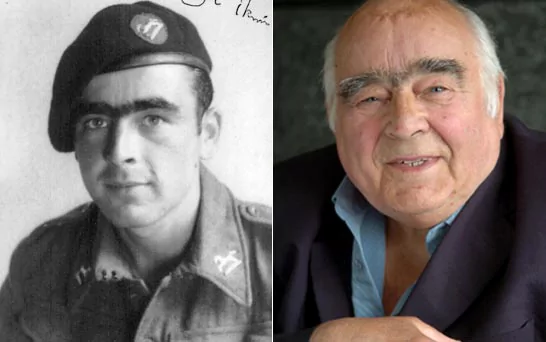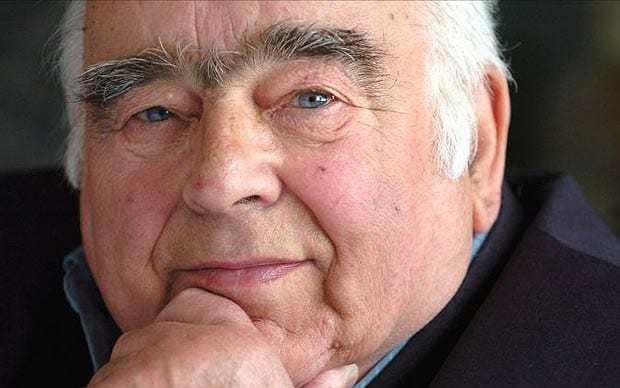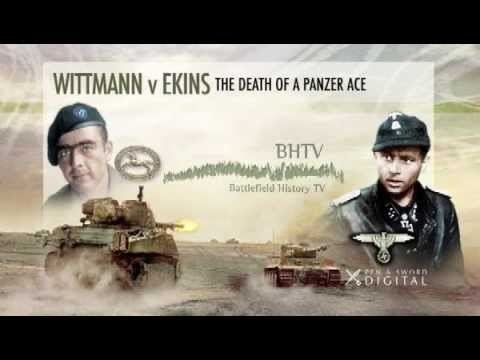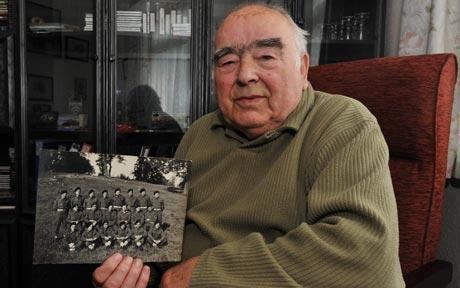Rank Trooper Name Joe Ekins | ||
 | ||
Battles/wars Second World WarBattle of NormandyOperation Totalize Battles and wars Operation Overlord, Operation Totalize, World War II | ||
Joe ekins red on black
Joe Ekins (15 July 1923 – 1 February 2012) was a World War II British Army veteran. He gained recognition for his action as a tank gunner in France in which he destroyed four tanks in a day, including three Tigers (Tiger tanks numbers 312, 009 & 314). One of his opponents on that day, 8 August 1944 near St. Aignan de Cramesnil, France may have been the German tank commander Michael Wittmann. However, in recent years it has been claimed [via Canadian researched, presented and produced episode] that Sherman or Sherman Fireflies tanks from the Canadian Sherbrooke Fusilier Regiment were responsible. Ekins died on 1 February 2012.
Contents
- Joe ekins red on black
- Joe Ekins Invisible
- Operation Totalize
- Speculation surrounding Wittmanns death
- Later life
- References

Joe Ekins - Invisible
Operation Totalize

During Operation Totalize the 1st Northamptonshire Yeomanry and elements of the 51st (Highland) Division reached the French village of St. Aignan de Cramesnil during the early morning of 8 August 1944. While B Squadron stayed around the village, A and C Squadrons moved further south into a wood called Delle de la Roque.

C Squadron positioned themselves on the east side of the woods and the understrength A Squadron positioned themselves in the southern portion, with '3 Troop' on the western edge of the wood. From this position they overlooked a large open section of ground and were able to watch as German tanks advanced up Route nationale 158 from the town of Cintheaux. On orders from the troop commander, they held their fire until the German tanks were well within range.

Ekins, the gunner of Sergeant Gordon's Sherman Firefly (called Velikiye Luki, as A Squadron's tanks were named after towns in the Soviet Union), had yet to fire his gun in action. With the Tiger tanks in range, the order was given to fire. What followed was an almost 12-minute battle that saw Ekins destroying all three Tigers that '3 Troop' could see (there were actually seven Tiger tanks in the area heading north, along with some other tanks and self-propelled guns).

A short time later, the main German counterattack was made in the direction of C Squadron. A Squadron (less Sgt Gordon, who had been wounded and had already bailed out of the Firefly) moved over to support them and in the resulting combat, Ekins destroyed a Panzer IV before his tank was hit and the crew was forced to bail out. Following the battle and tankless, Ekins was reassigned to another tank within the squadron as a radio operator and remained in this position for the rest of the war.
Speculation surrounding Wittmann’s death

Following the war, claims were made by or for the following units as being responsible for Wittmann's death: 1st Polish Armoured Division, the 4th Canadian Armoured Division, the 144th Regiment Royal Armoured Corps, and the RAF Second Tactical Air Force. Reid examined these claims and dismissed them based on the units' war diaries.
In a 1985 issue of After the Battle Magazine, Les Taylor, a wartime member of the 1st Northamptonshire Yeomanry, claimed that fellow yeoman Ekins was responsible for the destruction of Wittmann's tank. Veteran and historian Ken Tout, a member of the same unit, also published a similar account crediting Ekins. Historians have supported this position, and it became the widely accepted version of events. According to Hart, Ekin's unit was positioned in a wood on the right flank of the advancing Tiger tanks. At approximately 12:47, they engaged them, halting the attack, and killing Wittmann.
Reid postulates that the A Squadron of the Sherbrooke Fusilier Regiment, 2nd Canadian Armoured Brigade, positioned on the left flank of the advancing German tanks, was responsible instead. Situated on the grounds of a chateau at Gaumesnil, the unit had created firing holes in the property’s walls and, engaged the advancing German tanks, including Tigers. The British tanks were between 1,000 metres (1,100 yd) and 1,200 metres (1,300 yd) away from the German line of advance, whereas the Canadian squadron was around 500 metres (550 yd) away.
Later life
After the war, Ekins returned to Rushden, Northamptonshire and went back to work in the shoe factories near his home town. He retired 34 years later, after becoming a manager of one of the factories. He married and had two children.
